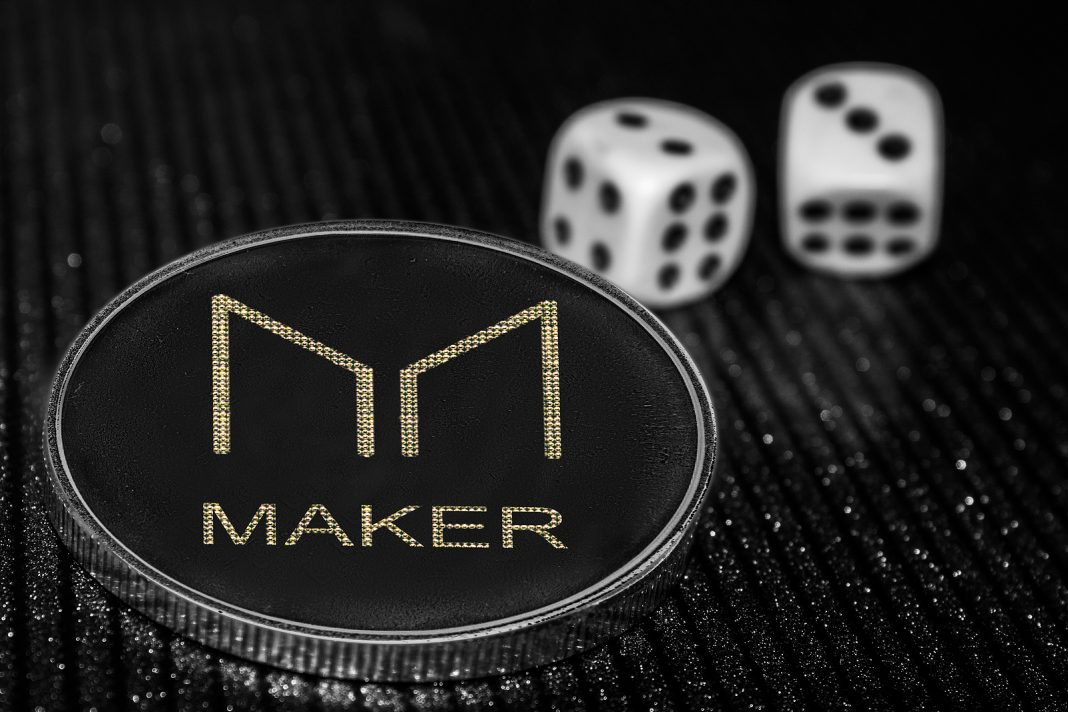MakerDAO or the Maker platform is one of the most influential projects in the DeFi space. It literally changed the game, took the attention away from staking and token offerings, and brought DeFi into the spotlight.
Fundamentally, Maker is known for being two things:
- A stablecoin issuance platform or generator
- A decentralized lending platform that enables individuals to put their crypto assets to work by locking up and leveraging them.
Maker might have lost its spot as the number one DeFi app, but it’s still one of the core platforms in the space. In this guide, we shall explore everything there is to know about the Maker Protocol, but more importantly, how to make money from the platform.
Table of Contents
What is MakerDAO?
MakerDAO is a decentralized autonomous organization (DAO) that develops and operates Maker, a smart contract platform for borrowing, saving, and issuing stablecoins. The new Multi-Collateral Dai (MCD) system enables users to generate a stablecoin called DAI by collateralizing assets accepted by the Maker governance community.
Maker stabilizes the value of the Dai stablecoin to $1 dollar through economic incentives and external market mechanisms. By minimizing price volatility, Dai aims to succeed where Bitcoin has allegedly failed — as a medium of exchange.
The Maker Protocol eliminates the need for a central authority by offering a completely transparent system that can be audited by anyone via the Ethereum blockchain.

Background
MakerDAO is an open-source project founded by Rune Christensen. It has operated since 2015 but didn’t show up for the spotlight until December 2017 when they released the first MakerDAO whitepaper.
A couple of years later, their application became the first to see significant adoption among DeFi projects and became the number one ranking DeFi dapp until Compound took their place.
Native Assets
Maker initially had two native assets up until the introduction of multi-collateral Dai, which enabled users to utilize other forms of collateral besides ETH.
DAI

Multi-collateral Dai (DAI) is a decentralized collateral-backed stablecoin pegged to the U.S. dollar. DAI can either be held in digital wallets, used as payment for goods and services, or traded on exchanges. Moreover, it is supported by Ethereum as well as other leading blockchains.
You could think of DAI as a normal decentralized cryptocurrency without the issue of volatility.
In order to generate Dai, users need to deposit supported assets as collateral into Maker Vaults. This is basically how the Dai minting and circulation process works. Another way to collect Dai is to accept it as payment or buy it from exchanges and brokers.
An important thing to note is that every stablecoin in circulation is backed by excess collateral, which means that the value of the locked-up assets in the Maker Protocol will always be higher than the total value of Dai debt in existence at any given time. This is a measure that helps prevent system collapse due to outstanding debt.
SAI
Sai or Single-Collateral Dai was the initial stablecoin issued by the Maker platform, which has now been superseded by Multi-collateral Dai (DAI). Unlike Dai, Sai only supports Ethereum as collateral.
MKR

MKR is the governance token of the Maker Protocol, which enables its holders to vote on upgrades and other changes to the system. One notable difference with Maker is that it allows anyone to submit proposals, not just the governors. However, normal users still can’t vote on them.
MKR holders can vote to add a new collateral asset type (precious metals, commodities, etc.), change risk parameters of the different asset types, choose the set of oracle feeds or emergency oracles, upgrade the system.
Whenever a proposal gets voted on and approved, it becomes effective in a few to several hours. This delay is necessary to give MKR holders a time allowance in order for them to protect the system in the unlikely event of a malicious governance proposal. In other words, it gives them time to deploy the ‘shutdown mechanism’.
MKR holders also have the power to allocate funds to pay for various infrastructure necessities and operations.
Liquidation Mechanims
Maker Vaults are smart contracts that allow the leveraging of collateral assets to generate Dai. On the other hand, they also burn Dai that has been used to repay debt in the system. They are inherently non-custodial, meaning no central entity controls them.
A Maker Vault is automatically liquidated through Maker protocol auctions once it becomes too risky. For instance, if a collateral asset’s market value crashes substantially, it poses a risk that the locked-up assets might become worth less than the outstanding debt. Therefore, the system has imposed collateralization thresholds to ensure this does not happen.
Once a liquidation occurs, users will incur to pay the Liquidation Penalty set by the MKR holders.
How to make money
Maker is not merely a stablecoin issuance platform. In fact, many investors participate for the sole purpose of making a profit. There are many ways to make money from Maker.
In this guide, we’ll discuss the two of them. But before we move forward, we need to generate Dai first. This isn’t a requirement since you can easily buy Dai on the market.
However, depositing collateral in exchange for Dai puts your assets to work. It allows you to leverage your assets while still being able to benefit if/when they increase in value.
For instance, you lock up 1 WBTC (Wrapped BTC) for six months and it doubles in that span of time. You could use the generated Dai for money-making schemes while still being able to withdraw your WBTC two months later by paying the Dai you owe.
Generating Dai
Multi Collateral Dai can be created through the Oasis App. Simply go to oasis.app/borrow. You’re going to need a wallet to connect to the Oasis first.

Oasis allows you to use Metamask, Coinbase Wallet, Wallet Connect, or the two most popular hardware wallets: Ledger and Trezor. Next, you must select a collateral type and click ‘Continue’. Follow the prompts to send some transactions while opening your vault and generating Dai.
You will be asked to fill out the amount of collateral you want to deposit, as well as the amount of Dai you like to generate. And remember, you cannot withdraw your collateral unless you pay back the Dai you’re about to generate.
Once everything is submitted, your new DAI should arrive in your wallet in a few minutes.
Dai Savings Rate (DSR)
The DSR will enable Dai holders to earn interest automatically by simply locking their Dai into a DSR contract. This provides investors the option to make a steady predictable income while waiting for better market conditions. Hodlers are probably the most suitable individuals to use DSR.
You could think of DSR as staking since you are basically locking up your asset for the purpose of helping the system. After all, the DSR helps balance the Maker Protocol by fine-tuning the supply and demand of Dai and to keep it stable at $1.
To participate, the first thing you need to do is to get Dai. You easily could buy them from online marketplaces or you could follow the steps in generating them from the Maker vaults as instructed earlier in the guide. Once that’s done, you can access the DSR interface through the ‘Oasis Save’ portal. Simply go to oasis.app/save and connect your wallet the same way you did when generating Dai.
Then, you have to set up a proxy and an allowance, which are smart contract functions that provide you with permission to move your Dai. This might sound complex, but fortunately, the smart contract does all the work for you. All you need to do is trigger the transactions by clicking the necessary prompts on Oasis and Metamask.
Once the transactions are completed, you can now deposit your Dai and begin earning interest. Input the amount you want to deposit and click ‘Deposit’. You will then need to click on Metamask for approval.

Once your deposit becomes successful, you can view your earnings on the left in real-time.
There are no minimum deposits required while users retain full control over their locked-up Dai at all times. The reward you will get from the DSR is determined by the MakerDAO participants and is funded through the different fees being used in the system.
Lending Dai on Compound

Another way to earn income with Dai is to deposit them in the Compound platform. This time, we are going to create cDAI out of Dai.
Compound has dethroned Maker as the leading DeFi application, therefore, it only makes sense that some investors might want to work their newly-issued Dai on Compound instead.
Firstly, you need to visit the Compound web app at app.compound.finance. Again, you will need to have a supported wallet to access the application. Once that’s been taken cared of, select Dai from the menu and click ‘Enable’.

You will then be prompted by Metamask to confirm. In order to follow the confirmation status of the transaction, open the Metamask menu, click the pending transaction, and then click the diagonal arrow on the right.
Once your transaction has been confirmed, click the ‘Supply’ button and input the amount of Dai you wish to supply. After entering the amount, click ‘Supply’ at the bottom of the pop-up which would trigger a Metamask prompt. Confirm the details of the transaction like before, then click ‘Confirm’.
You will have your cDAI in your Metamask wallet in a few minutes. With it, you will be able to gain passive interest every 10-19 seconds. To view the interest rates beforehand, visit Defipulse under DAI Asset and check the APR.
How Safe is Maker?
The two greatest risks of investing in DeFi platforms are systemic vulnerabilities and massive price drops.
Several DeFi platforms have been hacked in the last few months, which proved that these systems are not totally as secure as hoped. But according to the Maker Foundation, security is their highest priority and that they have dedicated a lot of resources to it.
They have launched a bug bounty program in October 2019, which resulted in bounty rewards totaling $90,000. They also plan to continue launching more bug bounty programs indefinitely.
The Multi-collateral Dai system’s core contracts have been formally verified, which they intend to continue for every change in the core protocols.
In addition, Maker is also being regularly audited by contracted traditional security firms such as Trail of Bits and Runtime Verification, as well as third-party security firms. With that being said, no DeFi platform is as safe as traditional financial systems as of yet.
On the economics side, the risk comes when the price of the underlying assets crash and drop below the liquidation ratio. This happened last March 12 when the price of ETH dropped from $191 to $88. At that time, gas prices were skyrocketing and there was so much chaos that MakerDAO was unable to perform liquidations properly.
Thankfully, the Maker governance system was quick to make emergency adjustments to the protocol and did an auction to liquidate assets. But not without losing $8 million worth of ETH.
Conclusion
As a top-of-the-line DeFi project, MakerDAO appears to be one of the most promising projects to date. Even today, they already offer several real-world solutions.
DAI can be used as a decentralized borderless cryptocurrency that is stable. Or, it can be leveraged to generate income for investors.
It needs to be noted that DeFi systems like Maker are still in their early stages; earlier than the crypto space itself. Therefore, one must only invest what they can afford to lose.



















